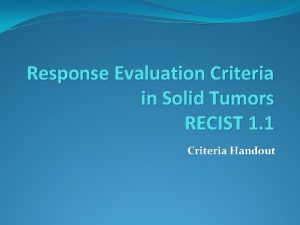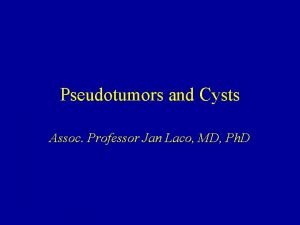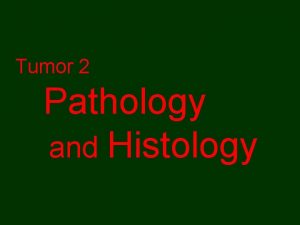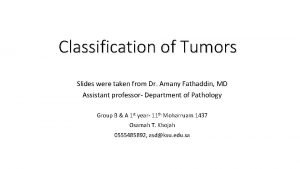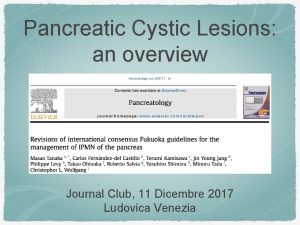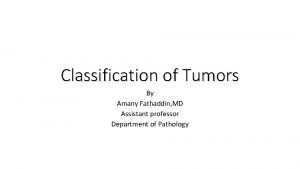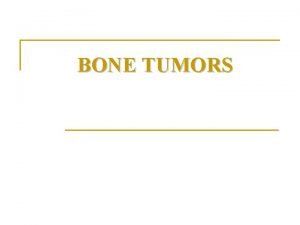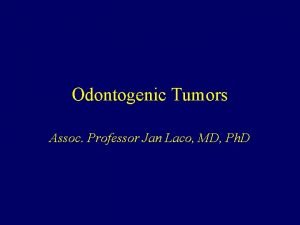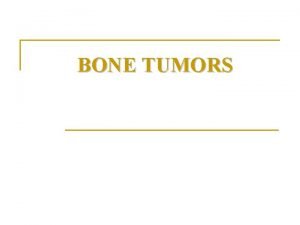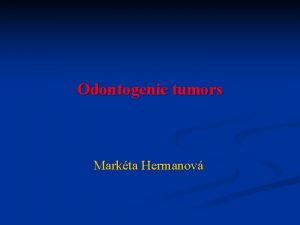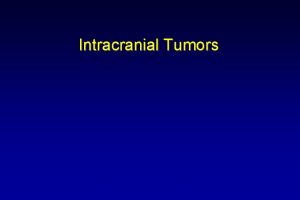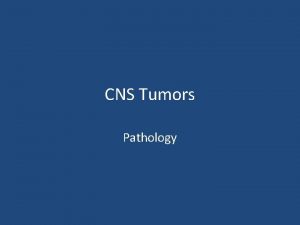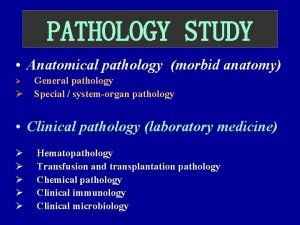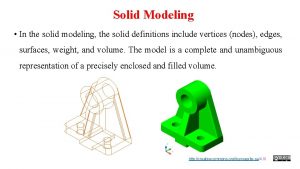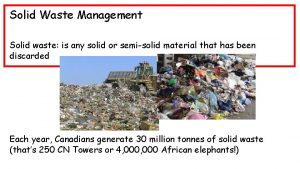Pathology of Solid Tumors Megan Troxell MDPh D






























- Slides: 30

Pathology of Solid Tumors Megan Troxell, MD/Ph. D OHSU Pathology troxellm@ohsu. edu 8 -1770

Objectives • • Diagnostic Techniques Common terminology, definitions in cancer Multi-step carcinogenesis Invasion & Metastasis Tumor grading Tumor staging Newer prognostic/predictive testing

http: //www. cancer. org

Diagnostic Methods in Tumor Pathology • Histology-morphology H=hematoxy lin, nucleic acids, purple E=eosin, protein, pink – ‘Old fashioned’ microscope, H &E slides, formalin fixed paraffin embedded (FFPE) • Immunohistochemistry Undiff. tumor – Esp. tumor differentiation, mitotic rate HMB 45+ Melanoma

Diagnostic Methods in Tumor Pathology Pediatric Kidney Cancer • Immunohistochemistry – May help subclassify – Rarely, may imply specific genetic rearrangement Loss of PMS 2 expression, colon cancer Mismatch repair protein deficient (Lynch) TFE 3 +nuclear Argani. AJSP 26: 1553 -66 Cancer Aberrant TFE 3 protein expression as a result of t(X; 1)(p 11. 2; q 21) Normal

(courtesy of Helen Lawce) t(11; 22) Ewing’s EWS-FLI 1 Breakapart FISH probe FISH & Cytogenetics Characteristic translocations Diagnostic Methods in Tumor Pathology

Diagnostic Methods in Tumor Pathology • Molecular/PCR – Esp. hematopathology • T- B-cell clonality • Characteristic mutations • (Coming: gene arrays, etc) FISH: Her 2 amplification (breast cancer) Courtesy Dana Bangs PCR/HPLC (WAVE) for C-kit mutations in GIST Corless Am J Pathol. 2002 160: 1567 -72

Nomenclature • Hypertrophy: increase in size of cells • Hyperplasia: increase in the # of cells in organ/tissue • Neoplasia: “new growth” – Growth exceeds/uncoordinated with normal tissue – Growth persists after stimulus removed – CLONAL – Benign or malignant – Neoplasm=proliferating cells & associated stroma

Neoplasia: Benign • Cohesive, expansile masses (tumors) • Remain localized – No capacity to invade, metastasize • Slow growing – Often encapsulated • Well differentiated (still resemble normal) • Often named with suffix “-oma” • • • Chondroma (benign neoplasm of cartilage) Hemangioma (benign neoplasm of blood vessels) Leiomyoma (benign neoplasm of smooth muscle) Adenoma (benign epithelial neoplasm) Cystadenoma, Papilloma etc

Neoplasia: Malignant • Invade and destroy surrounding tissue • Capacity for metastasis – Spread through blood vessels/lymphatics to distant sites • • • Higher rate of growth Pleomorphism (variation in size/shape) Abnormal nuclear morphology & hyperchromasia De-differentiation/Anaplasia Nomenclature: – – – Malignant epithelial neoplasm: carcinoma Malignant mesenchyma: sarcoma Malignant hematolymphoid: leukemia, lymphoma Malignant melanocytic: melanoma Malignant germ cell: seminoma, and others

Neoplasia: Benign vs. Malignant Robbins 7 -22 Uterus

Normal, Benign, Malignant Normal colon and invasive adenocarcinoma (right, Malignant) Normal colon (lower) & tubular adenoma (benign, upper left)

Adenoma, colon (TVA)

Normal, Benign, Malignant Normal breast Benign hyperplasia Invasive carcinoma

Histologic Features of Malignant Cells http: //www. usc. edu/hsc/dental/ PTHL 312 abc/312 a/05/Reader/rea der. html

Transformation • “Malignant change in the target cell” • What features define a transformed cell? Hanahan and Weinberg. “The Hallmarks of Cancer” Cell. 100: 57 -70. 2000 And Genomic Instability

Transformation: Darwinian? • “Malignant change in the target cell” Mechanisms & chronology of acquired capabilities vary By organ/tumor type By subtype, etc Hanahan and Weinberg. “The Hallmarks of Cancer” Cell. 100: 57 -70. 2000

“The Genomic Landscapes of Breast and Colorectal Cancer” Wood et al. Science. 2007 318: 1108 -113

“Tumors as Complex Tissues” or, “It takes a village” Hanahan and Weinberg. “The Hallmarks of Cancer” Cell. 100: 57 -70. 2000

Concept: Carcinoma in situ (CIS) • Malignant cells that have not yet breached the basement membrane (still confined) DCIS & invasive DCIS: breast

Carcinoma In Situ (right) and Invasive carcinoma (left), breast Calponin p 63

Carcinoma in in situ (CIS) Carcinoma Squamous Cell CIS Squamous CIS Invasive SCC

1’tumor Invasion & metastasis BM Vein Lymph Platelets ECM Artery Colon CA in lymphatic channel Vein Artery Robbins 7 -42

Tumor growth and spread Normal cell (Lung) Single tumor cell 30 doublings 1 gm=109 cells Smallest clinically detectable mass 10 doublings 1 kg=1012 cells Maximum mass compatible w/ life Liver mets Robbins 7 -12

Tumor angiogenesis Leaky vessels Robbins 7 -41

Transformation • Some benign neoplasms have propensity to acquire additional genetic changes and progress to malignancy (precursors) – Example: colonic adenoma carcinoma • Others rarely undergo transformation – Example: Uterine leiomyomas, salivary gland pleomorphic adenomas

Histologic and Molecular Progression: Colon LG dysplasia APC b-cat Robbins. 7 th ed. Figure 17 -60 HG dysplasia Kras P 53 18 q 21 SMAD 2, 4 Carcinoma Telomerases, etc

It’s never that simple… http: //www. rr-research. no/wcache/650 x_58 df 157 ee 0 b 2 a 665 ce 8 c 99 e 0 dd 99 e 435 Adenoma_carcinoma. jpg

http: //www. mdconsult. com/das/book/body/128522719 -2/0/1492/f 4 -u 1. 0 -B 978 -1 -4160 -2805 -5. . 50208 -1. . gr 5. jpg from Cecil Medicine 23 ed (Saunders, Elsevier)

Histologic and molecular progression: Breast True precursor? Normal Florid proliferation ADH Non-obligate precursor? DCIS Infiltrating Carcinoma Tissue Invasion Robbins Fig 23 -15
 Response evaluation criteria in solid tumors (recist)
Response evaluation criteria in solid tumors (recist) Rqth avantages
Rqth avantages Modèle lettre projet de vie mdph adulte
Modèle lettre projet de vie mdph adulte Mdph
Mdph Odontogenic tumors classification
Odontogenic tumors classification Spinal cord
Spinal cord Thyroid grading system
Thyroid grading system Adenocarcinoma
Adenocarcinoma Malignant and benign tumors
Malignant and benign tumors Enneking classification
Enneking classification Brain tumors
Brain tumors Local invasion
Local invasion Exocrine tumors of pancreas
Exocrine tumors of pancreas Bone tumors
Bone tumors Odontogenic tumors
Odontogenic tumors Chest wall tumors
Chest wall tumors Classification de robbins
Classification de robbins Classification of tumors
Classification of tumors Exostosis
Exostosis Ameloblastoma rtg
Ameloblastoma rtg Brain tumors
Brain tumors Ectocervix
Ectocervix Mixture evaporation
Mixture evaporation Anisotropic meaning in chemistry
Anisotropic meaning in chemistry Example of crystalline solid
Example of crystalline solid When a solid completely penetrates another solid
When a solid completely penetrates another solid Honors its atomic
Honors its atomic Crystalline solid
Crystalline solid Example of a solid solution?
Example of a solid solution? Crystalline solid and amorphous solid
Crystalline solid and amorphous solid Interpenetration of surfaces
Interpenetration of surfaces
